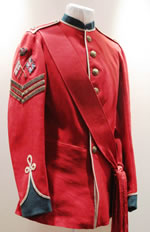Museum of the Manchester Regiment Object Focus
Colour Sergeant’s Tunic of the 63rd Regiment
 We do not know who wore this tunic. However, if we look at the tunic closely we can learn many things about its history and the man who wore it.
We do not know who wore this tunic. However, if we look at the tunic closely we can learn many things about its history and the man who wore it.
Scarlet tunics, in this pattern, were approved for all ranks in 1872.
The style of crown shown above the crossed flags is often called a ‘QVC’ or ‘Queen Victoria’s Crown’ and reflects the reign of Queen Victoria (1837-1901).
The three chevrons and crossed flags on the right sleeve tell us that he is a Colour Sergeant. Colour Sergeants were originally tasked with protecting the officer carrying the Colours.
The rank of ‘Colour Sergeant’ was prestigious and only given to courageous Sergeants who had proven themselves in battle. This tradition continues today as Colour Sergeants form part of the ‘Colour Party’ in military parades. The rank of Colour Sergeant was introduced in 1813.
The 63rd Regiment used green ‘facings’ on their collar and cuffs. The Regimental number is clearly visible on the shoulder straps.
This NCO (Non-Commissioned Officer) is also entitled to wear the scarlet sash that you can see here, as a symbol of his rank.
The pattern of braid used on the sleeve is known as a ‘Crows foot’ or ‘Trefoil’ and is a decorative element used on some military uniforms.
Down the front of the tunic are 7 ‘Universal Pattern’ buttons, introduced in 1871. Each button bears the Royal Coat of Arms.

